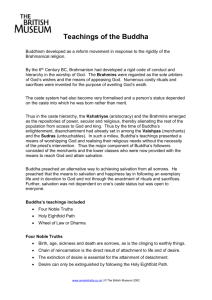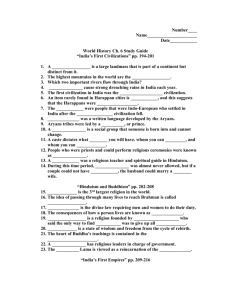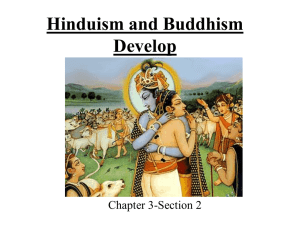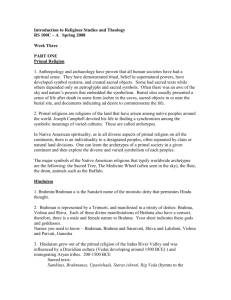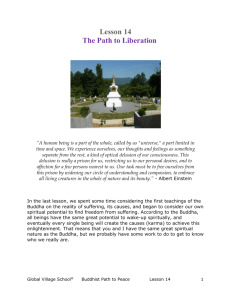From the Art Institute of Chicago
advertisement
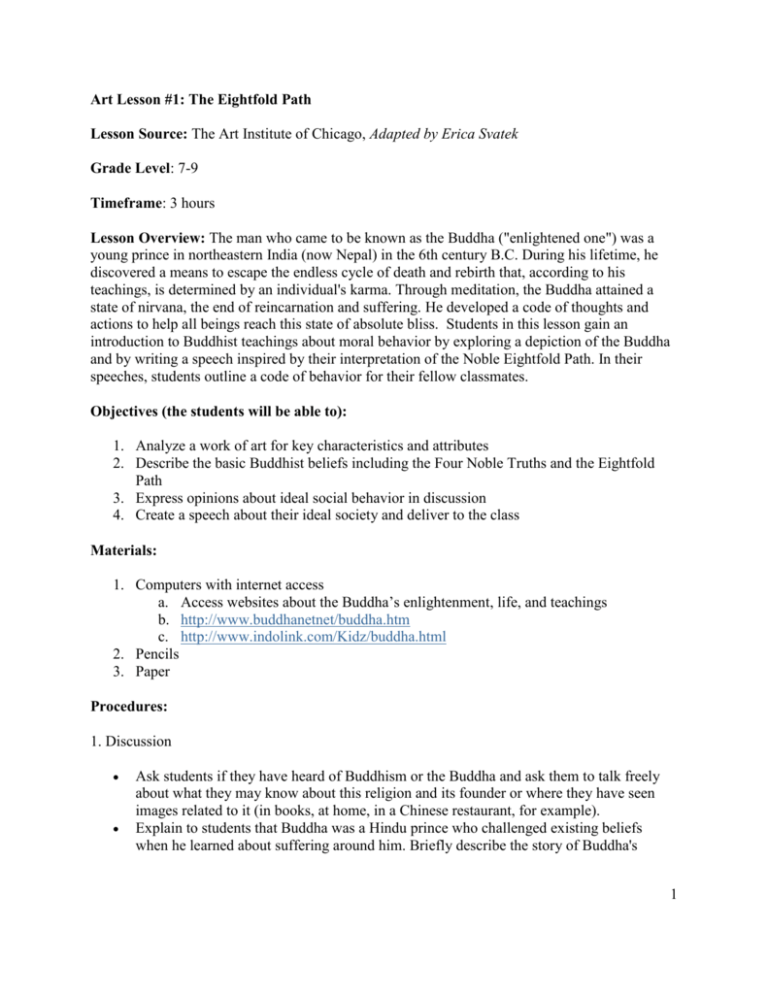
Art Lesson #1: The Eightfold Path Lesson Source: The Art Institute of Chicago, Adapted by Erica Svatek Grade Level: 7-9 Timeframe: 3 hours Lesson Overview: The man who came to be known as the Buddha ("enlightened one") was a young prince in northeastern India (now Nepal) in the 6th century B.C. During his lifetime, he discovered a means to escape the endless cycle of death and rebirth that, according to his teachings, is determined by an individual's karma. Through meditation, the Buddha attained a state of nirvana, the end of reincarnation and suffering. He developed a code of thoughts and actions to help all beings reach this state of absolute bliss. Students in this lesson gain an introduction to Buddhist teachings about moral behavior by exploring a depiction of the Buddha and by writing a speech inspired by their interpretation of the Noble Eightfold Path. In their speeches, students outline a code of behavior for their fellow classmates. Objectives (the students will be able to): 1. Analyze a work of art for key characteristics and attributes 2. Describe the basic Buddhist beliefs including the Four Noble Truths and the Eightfold Path 3. Express opinions about ideal social behavior in discussion 4. Create a speech about their ideal society and deliver to the class Materials: 1. Computers with internet access a. Access websites about the Buddha’s enlightenment, life, and teachings b. http://www.buddhanetnet/buddha.htm c. http://www.indolink.com/Kidz/buddha.html 2. Pencils 3. Paper Procedures: 1. Discussion Ask students if they have heard of Buddhism or the Buddha and ask them to talk freely about what they may know about this religion and its founder or where they have seen images related to it (in books, at home, in a Chinese restaurant, for example). Explain to students that Buddha was a Hindu prince who challenged existing beliefs when he learned about suffering around him. Briefly describe the story of Buddha's 1 enlightenment (see recommended references). Ask students why they think it might have been desirable to Buddha for humans to escape the cycle of death and rebirth. Discuss the concept of enlightenment. Ask students if they have experienced a series of events that also has led them to a new and better way of thinking. Have students examine a printout or digital image of Buddha Shakyamuni. Ask students to describe the details of the work, guiding them to each of the significant features of the enlightened Buddha. o ushnisha o Urna o short hair o elongated earlobes o mudras Explain that in most representations the enlightened Buddha can be recognized by these features, and introduce students to their meaning. Explain that after his enlightenment at the age of 35, Buddha traveled around India for 45 years teaching others what he had learned and suggesting a code for living. In his first speech, Buddha introduced his understanding of the Four Noble Truths. o All life is suffering. o Suffering is caused by desire. o To eliminate suffering, eliminate desire. o To eliminate desire, follow the Noble Eightfold Path. Discuss students' initial interpretation. Tell students that in Buddhism, an individual is not judged by God. Morality is left up to the individual and is expressed through accumulated actions (karma). The Noble Eightfold Path is at the center of daily Buddhist practices. It is not a ritual performed by priests but a guide for all people to live by (dharma). It means adopting right (true or correct) views, right thoughts, right conduct, right speech, right livelihood, right effort, right mindfulness (putting aside greed and distress), and right meditation. The reward for following the Noble Eightfold Path is the achievement of nirvana. 2. Activity Write the elements of the Noble Eightfold Path on the chalkboard and ask students to discuss their possible meanings for 10 to 15 minutes. Have students discuss the elements of the Noble Eightfold Path in relation to students' behavior in their classroom and school for another 10 minutes. Ask students to complete a two- to three-page speech titled "How to Be More Compassionate in School," in which they prescribe a code of living for fellow students in their classroom or at school. Ask them to provide examples of how the lives of their fellow students might be improved by such actions. 2 Closure: 1. Have students designate a special place in the classroom and read their speeches aloud or post speeches for other students to read. Suggested Evaluation: Base students' achievements on their participation in class discussions and oral presentations. How much do their comments and speeches reveal an understanding of basic Buddhist beliefs? Did students present thoughtful, critical reflections on these beliefs and their relationship to group behavior in school? Extensions: Use this lesson as a preparatory exercise for students' participation in the Gandhi/King Legacy Celebration of Peace Essay Contest. The contest is sponsored by the Dharma Foundation, the Indo-American Center, and the Center for Asian Arts and the Media at Columbia College. For more information see www.indoamerican.org/gandhiking. 3




